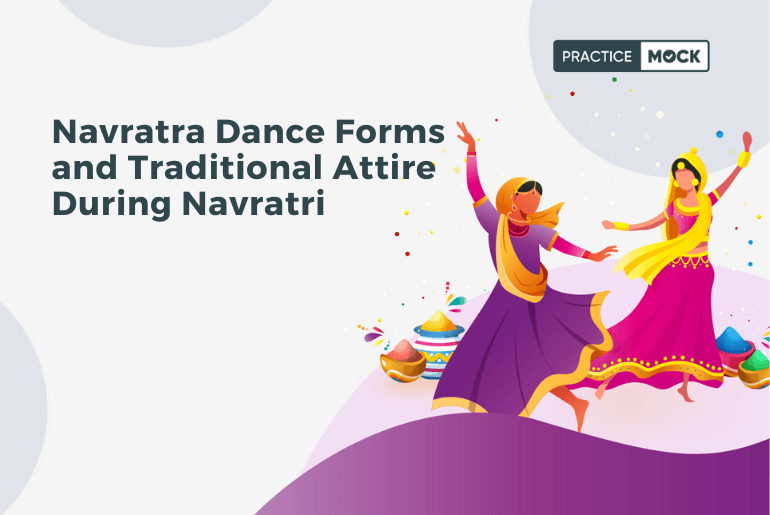Navratra Dance Forms and Traditional Attire During Navratri: Navratri is a vibrant and joyous Hindu festival celebrated with great fervor and enthusiasm across India. It spans nine nights and ten days, dedicated to the worship of the goddess Durga in her various forms. One of the most captivating aspects of Navratri is the traditional dance forms and attire that come to life during this auspicious period.
The Spirit of Navratri:
Navratri, which translates to “nine nights,” is a celebration of the divine feminine energy. It is observed twice a year, once in the spring (Chaitra Navratri) and once in the autumn (Sharad Navratri). The latter, Sharad Navratri, is the most widely celebrated and marks the beginning of the autumn season.
During this period, people gather to pray, dance, and revel in the divine aura. The energy is electrifying, with music, dance, and vibrant colors dominating the scene. Devotees engage in fasting, prayer, and meditation to purify the body and mind while seeking the blessings of the goddess Durga.
Navratri Dance Forms:
Dance is an integral part of Navratri celebrations. Various dance forms emerge during this time, each with its unique style and significance. Some of the most popular Navratri dance forms include:
1. Garba:
Garba is perhaps the most renowned and widely performed Navratri dance form. Originating from Gujarat, it is a circular dance performed by women and men. Dancers form concentric circles and perform intricate footwork, clapping their hands to the rhythm of the music. The graceful movements and vibrant costumes make Garba a mesmerizing sight.
2. Dandiya Raas:
Dandiya Raas is often performed in pairs and involves colorful sticks called “dandiyas.” Partners engage in a rhythmic and energetic dance, striking their sticks against each other’s while following the music. The synchronized movements and striking of dandiyas create a festive atmosphere.
3. Ras Leela:
Ras Leela is a traditional dance form that originated in the Braj region of North India. It portrays the divine love between Lord Krishna and Radha. Dancers wear elaborate costumes resembling Krishna and Radha and depict their romantic episodes through graceful and expressive movements.
4. Garbi:
Garbi is a dance form popular in the Kutch region of Gujarat. It is performed by women who carry an earthen pot with a diya (lamp) on their heads. The dance is characterized by fast footwork and graceful spins while balancing the pot. It symbolizes the offering of light and devotion to the goddess Durga.
5. Bhavai:
Bhavai is a folk dance form that involves balancing a stack of brass pitchers on the head while performing intricate dance moves. It requires great skill and is often performed by women from Rajasthan during Navratri.
Traditional Attire During Navratri:
Traditional attire adds to the festive spirit of Navratri. People take great care in choosing their outfits, which are often colorful and vibrant. Here are some traditional garments commonly worn during Navratri:
1. Chaniya Choli:
Chaniya Choli is the traditional attire for women during Navratri. It consists of a flared skirt (chaniya), a blouse (choli), and a matching dupatta. These garments are adorned with intricate mirror work, embroidery, and vibrant colors. Women accessorize their outfits with jewelry, bangles, and decorative hairpins.
2. Kurta-Pajama for Men:
Men typically wear traditional Kurta-Pajama or dhoti during Navratri. These garments are often made from silk or cotton and are paired with a colorful jacket or Nehru vest. Men may also accessorize with turbans and embroidered shawls.
3. Odhni or Dupatta:
Both men and women often wear an odhni or dupatta, which is a colorful scarf or shawl. It adds an extra layer of grace to the outfit and can be draped in various styles.
4. Jewelry:
Traditional jewelry plays a crucial role in completing the Navratri look. Women adorn themselves with heavy earrings, necklaces, bangles, and nose rings. These accessories are often made of silver, gold, or artificial materials but are always eye-catching.
In conclusion, Navratri is a time of vibrant celebrations and spiritual devotion. The traditional dance forms and attire associated with Navratri are a testament to the rich cultural diversity of India. Whether it’s the graceful Garba, energetic Dandiya Raas, or the resplendent Chaniya Choli, Navratri is a festival that combines artistry, spirituality, and a sense of community that is truly unique. As we celebrate this auspicious occasion, let us revel in the colors, rhythms, and traditions that make Navratri a truly enchanting and unforgettable experience.
- Sign Up on Practicemock for Updated Current Affairs, Free Topic Tests and Free Mini Mocks
- Sign Up Here to Download Free Study Material
Free Mock Tests for the Upcoming Exams
- IBPS PO Free Mock Test 2024
- RBI Grade B Free Mock Test 2024
- IBPS SO Free Mock Test 2024
- NABARD Grade A Free Mock Test 2024
- SSC CGL Free Mock Test 2024
- IBPS Clerk Free Mock Test 2024
- IBPS RRB PO Free Mock Test 2024
- IBPS RRB Clerk Free Mock Test 2024
- RRB NTPC Free Mock Test 2024
- SSC MTS Free Mock Test 2024
- SSC Strenographer Free Mock Test 2024
- GATE Mechanical Free Mock Test 2024
- GATE Civil Free Mock Test 2024
- RRB ALP Free Mock Test 2024
- SSC CPO Free Mock Test 2024
- AFCAT Free Mock Test 2024
- SEBI Grade A Free Mock Test 2024
- IFSCA Grade A Free Mock Test 2024
- RRB JE Free Mock Test 2024
- Free Banking Live Test
- Free SSC Live Test


